What is a ColecoVision ? |
|
BEFORE COLECOVISION
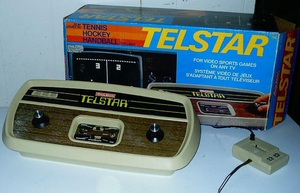 Coleco (a contraction of COnneticut LEather COmpany) was the first company to introduce a "dedicated chip" home video game system, with the Telstar Arcade in 1976. (The Magnavox Odyssey, based on Analog technology, was the first home video game system overall, debuting in 1973.)
Coleco (a contraction of COnneticut LEather COmpany) was the first company to introduce a "dedicated chip" home video game system, with the Telstar Arcade in 1976. (The Magnavox Odyssey, based on Analog technology, was the first home video game system overall, debuting in 1973.)
Trying to build upon the enormous initial success of the unit, Coleco decided to bring out nine different Telstar models. But within a year, 75 other manufacturers had introduced similar units, and combined with production snags, a shortage of chips, and a push towards hand held games, Coleco skirted with disaster.
While Coleco sold over $20 million of hand held games, it had to dump over a million Telstar units, and the company lost $22.3 million in 1978. With the introduction of units with games stored on interchangeable cartridges, Fairchild and then Atari had eliminated any remaining market for the simple pong games.
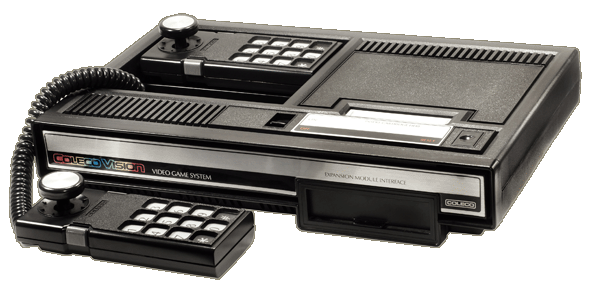
THE BEGINNING
 On June 1, 1982, Coleco re-entered the fray with the announcement of its "third generation" video game system, ColecoVision. Touting "arcade quality", ColecoVision took aim at the seemingly unassailable Atari 2600. Coleco wanted "Donkey Kong", a very hot arcade hit, to be their pack-in. In December '81, they went to Japan to make a deal with Nintendo for the rights to Donkey Kong. The Coleco executive wanted to return to the US to show his lawyers the contract before signing, but was told to sign now, or risk losing Donkey Kong to Atari or Mattel, who were currently going though channels to get the rights themselves. Under the pressure, the Coleco executive signed.
On June 1, 1982, Coleco re-entered the fray with the announcement of its "third generation" video game system, ColecoVision. Touting "arcade quality", ColecoVision took aim at the seemingly unassailable Atari 2600. Coleco wanted "Donkey Kong", a very hot arcade hit, to be their pack-in. In December '81, they went to Japan to make a deal with Nintendo for the rights to Donkey Kong. The Coleco executive wanted to return to the US to show his lawyers the contract before signing, but was told to sign now, or risk losing Donkey Kong to Atari or Mattel, who were currently going though channels to get the rights themselves. Under the pressure, the Coleco executive signed.
In April '82 Coleco and Nintendo were threatened with lawsuits from Universal Studios who claimed Donkey Kong was an infringement on their King Kong. Coleco had invested a fortune in the ColecoVision version of Donkey Kong that was only 4 months from its premiere release. Thinking that they didn't stand a chance in court, Coleco decided to settle, agreeing to pay Universal 3% of all Donkey Kong sales. Nintendo decided to fight it, and some time later actually won. Coleco then filed suit and got some of their lost royalties back.
The bulk of Coleco's library, however, was comprised of overlooked coin-op games such as Venture and Lady Bug. With a library of twelve games, and a catalog showing ten more on the way (many of which were never released), the first one million ColecoVisions sold in record time. In 1983 it topped sales charts, beating out Atari and Mattel, with much of its success being contributed to its pack-in, Donkey Kong.
The ColecoVision soon had more cartridges than any system except the Atari 2600, and with the 2600 converter still today has more playable games than any other system.
 The ColecoVision introduced two new concepts to the home videogame industry - the ability to expand the hardware system, and the ability to play other video game system games.
The ColecoVision introduced two new concepts to the home videogame industry - the ability to expand the hardware system, and the ability to play other video game system games.
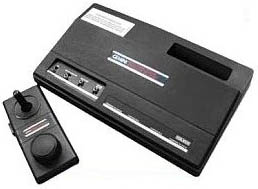 The Atari 2600 expansion kit caused a flurry of lawsuits between Atari and Coleco. After the dust cleared, the courts had decided that it was acceptable for Coleco to sell the units. As a result of this Coleco was also able to make and sell the Gemini game system which was an exact clone of an Atari 2600 with combined joystick/paddle controllers.
The Atari 2600 expansion kit caused a flurry of lawsuits between Atari and Coleco. After the dust cleared, the courts had decided that it was acceptable for Coleco to sell the units. As a result of this Coleco was also able to make and sell the Gemini game system which was an exact clone of an Atari 2600 with combined joystick/paddle controllers.
Coleco was also the first home videogame maker to devote the majority of their product line to arcade conversions, using the superior graphics of the ColecoVision to produce nearly arcade-quality games, albeit often missing a screen or level.
Coleco truly shocked the industry by doing so well. In a year, the stock rose in value from 6 7/8 a share to 36 3/4. The following items were taken from Fortune on March 7, 1983:
Fortune on March 7, 1983:
"Six months ago, hardly anyone expected Coleco to ride so high. [Company President Arnold] Greenberg was known in the industry as a self-promoter overly sanguine about Coleco's prospects. Says one security analyst: "He was always gilding the lily. Wall Street developed a basic distrust of the company." So did the Securities and Exchange Commission. In 1980 it charged Coleco with misstating financial results to mask troubles."
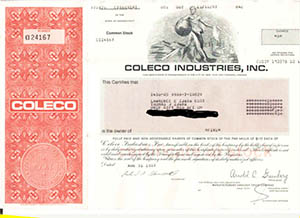 "But almost overnight Coleco's image has changed. ColecoVision, the video game player introduced last August, is one of the most popular consumer products around. The trade, paying homage to its technological advancement, has dubbed it "the third wave" - wave one being the Atari VCS, wave two being Mattel's Intellivision - and the most discerning critics, kids, love it. The 550,000 game players Coleco made last year flew off the shelves by Christmas-time. Coleco's sales nearly tripled from $178 million in 1981 to $510 million last year, and the net income shot up 420% to $40 million."
"But almost overnight Coleco's image has changed. ColecoVision, the video game player introduced last August, is one of the most popular consumer products around. The trade, paying homage to its technological advancement, has dubbed it "the third wave" - wave one being the Atari VCS, wave two being Mattel's Intellivision - and the most discerning critics, kids, love it. The 550,000 game players Coleco made last year flew off the shelves by Christmas-time. Coleco's sales nearly tripled from $178 million in 1981 to $510 million last year, and the net income shot up 420% to $40 million."
"Coleco's charge into the market last summer was well timed. Atari and Mattel were engaged in a multimillion-dollar mud-slinging battle on television. George Plimpton in Mattel commercials lampooned the graphics on Atari's VCS game player, while Atari blasted Intellivision's dearth of hit games. Then Coleco suddenly arrived on the scene with the best of both: good graphics and good games. With a greater amount of memory allocated to screen graphics, ColecoVision provided a much better picture than Atari. Although ColecoVision at $175 was $75 more expensive than Atari's VCS, discerning video players were willing to pay a higher price for more lifelike graphics. ColecoVision's pictures were also better than those of Intellivision, and the retail was $35 lower."
"To make ColecoVision even more attractive the company gave away with each unit a $35 Donkey Kong cartridge. "Donkey Kong was a very serviceable gorilla," says Greenberg. "Once we convinced the consumer of the merits of the hardware, Donkey Kong pushed him into buying.""
 "Another popular feature has been ColecoVision's expandability. Accessories like the $55 Turbo module, a steering wheel, gas pedal, and gear shift used to play a road racing game, can be plugged into the console. The company's $60 Atari adapter enables ColecoVision to play Atari VCS-compatible cartridges. Atari doesn't approve - it's suing Coleco for $850 million, charging patent infringement - but game addicts do. Coleco sold 150,000 Atari adapters in just two months. Coleco's latest add-on, the Super Game module, was shown at last week's American Toy Fair. It adds more memory to ColecoVision and provides additional play variations."
"Another popular feature has been ColecoVision's expandability. Accessories like the $55 Turbo module, a steering wheel, gas pedal, and gear shift used to play a road racing game, can be plugged into the console. The company's $60 Atari adapter enables ColecoVision to play Atari VCS-compatible cartridges. Atari doesn't approve - it's suing Coleco for $850 million, charging patent infringement - but game addicts do. Coleco sold 150,000 Atari adapters in just two months. Coleco's latest add-on, the Super Game module, was shown at last week's American Toy Fair. It adds more memory to ColecoVision and provides additional play variations."
"Coleco's software approach was to go after licensed arcade games and to make cartridges for Atari's VCS and Intellivision in addition to it's own game player. Although Coleco hadn't built a single ColecoVision when it was negotiating licensees in 1981, the licensers liked Coleco's plan to make products for all three leading game systems. Coleco reached agreements with five firms, landing nine hit arcade licensees. Last year the company sold eight million cartridges."
"Flush with last year's successful foray in video games, Arnold Greenberg predicts even more good news is on the way. "We are a terror in the marketplace," he boasts. Greenberg proclaims that Coleco will increase it's market share in video game players this year from 8% to 25%, supplanting Mattel as No. 2."
"Achieving such lofty goals may be difficult. Coleco last year paid only $250,000 for the rights to Donkey Kong, but Atari later had to pay an estimated $21 million to license E.T. for it's coin-operated and home video games. Late last year Coleco reached an agreement with the game maker Centuri for licenses to three arcade games: Phoenix, Vanguard, and Challenger. Then just before the contract was to be signed, Atari won the license by making a higher offer. Parker Brothers also outbid Coleco for the Popeye license. "Coleco's position is still not assured," says Barbara S. Isgur, a security analyst at Paine Webber. "They were helped last year by the phenomenal success of Donkey Kong. What will they do for an encore?"
 "Arnold Greenberg remains optimistic. He notes that Coleco has already signed license agreements to bring out 30 new games by year-end. In January, Coleco made CBS the principal foreign distributor for it's products. In return Coleco will begin developing and marketing for ColecoVision home video cartridges licensed by CBS from Bally, a major arcade game maker."
"Arnold Greenberg remains optimistic. He notes that Coleco has already signed license agreements to bring out 30 new games by year-end. In January, Coleco made CBS the principal foreign distributor for it's products. In return Coleco will begin developing and marketing for ColecoVision home video cartridges licensed by CBS from Bally, a major arcade game maker."
THE GREAT VIDEO GAME SHAKE-OUT OF 1984
 Unfortunately, the ColecoVision suffered the same fate as the rest in the great video game shake-out of 1984. Coleco's unsuccessful bug-ridden ADAM computer only complicated the problem; running behind schedule, Coleco is rumored to have used another manufacturer's computer as the Adam prototype at a CES show while at the same time Adam software was being developed with the system. Some believe if it wasn't for Coleco's Cabbage Patch dolls, they would have completely disappeared.
Unfortunately, the ColecoVision suffered the same fate as the rest in the great video game shake-out of 1984. Coleco's unsuccessful bug-ridden ADAM computer only complicated the problem; running behind schedule, Coleco is rumored to have used another manufacturer's computer as the Adam prototype at a CES show while at the same time Adam software was being developed with the system. Some believe if it wasn't for Coleco's Cabbage Patch dolls, they would have completely disappeared. 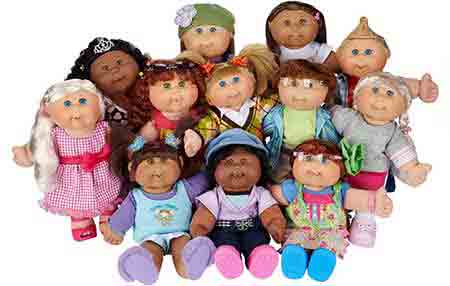 Even the Cabbage Patch dolls couldn't keep Coleco going forever, though; the company went under for good a few years later. Ironically, Mattel (the producers of Intellivision) now own the rights to the Cabbage Patch dolls.
Even the Cabbage Patch dolls couldn't keep Coleco going forever, though; the company went under for good a few years later. Ironically, Mattel (the producers of Intellivision) now own the rights to the Cabbage Patch dolls.
Coleco stopped production of the ColecoVision in 1984. Their last few titles (Illusions, Spy Hunter, Telly Turtle, and Root Beer Tapper) were barely seen in stores.
![]() When Coleco left the industry they had sold more than 6 million ColecoVisions in just two years, even with the last year being troubled by the shake-out. Many in the industry believe if it wasn't for the videogame crash of '84, that Coleco could have gone through the 80's as the system of choice, especially with its proposed Super Game Module. It was clearly beating Atari and Mattel, but just didn't have the installed base to last out the crash.
When Coleco left the industry they had sold more than 6 million ColecoVisions in just two years, even with the last year being troubled by the shake-out. Many in the industry believe if it wasn't for the videogame crash of '84, that Coleco could have gone through the 80's as the system of choice, especially with its proposed Super Game Module. It was clearly beating Atari and Mattel, but just didn't have the installed base to last out the crash.
COLECOVISION WITHOUT COLECO
![]() Almost immediately after Coleco stopped producing the ColecoVision, Telegames acquired the rights to the ColecoVision and bought most of Coleco's stock. The Britain- based company also released a few titles of its own. In 1985, Telegames began manufacturing and
Almost immediately after Coleco stopped producing the ColecoVision, Telegames acquired the rights to the ColecoVision and bought most of Coleco's stock. The Britain- based company also released a few titles of its own. In 1985, Telegames began manufacturing and  distributing the Bit Corporation-designed Dina 2-in-1 ColecoVision clone. Telegames renamed the console the Telegames Personal Arcade, and has continued selling them to this day. It's much smaller than the original ColecoVision and uses joypads instead of the awkward ColecoVision stick. The pads have no numeric keypad, which is instead built into the unit. There is only one keypad, however, so two- player games requiring the keypad won't work on the Personal Arcade. The Personal Arcade also has an expansion port, but its physical configuration makes it incompatible with Coleco's expansion units. In addition, there have been a number of claims that some Personal Arcade machines have a defect where the screen RAM chips are fed too much voltage. As a result, these machines can become permanently damaged after even short periods of play. The Personal Arcade console comes with its own built-in game, Meteoric Shower.
distributing the Bit Corporation-designed Dina 2-in-1 ColecoVision clone. Telegames renamed the console the Telegames Personal Arcade, and has continued selling them to this day. It's much smaller than the original ColecoVision and uses joypads instead of the awkward ColecoVision stick. The pads have no numeric keypad, which is instead built into the unit. There is only one keypad, however, so two- player games requiring the keypad won't work on the Personal Arcade. The Personal Arcade also has an expansion port, but its physical configuration makes it incompatible with Coleco's expansion units. In addition, there have been a number of claims that some Personal Arcade machines have a defect where the screen RAM chips are fed too much voltage. As a result, these machines can become permanently damaged after even short periods of play. The Personal Arcade console comes with its own built-in game, Meteoric Shower.
Also Adam's House/eColeco was contacted by Coleco and bought some of the remaining stock. - 66
 In April 1994, Telegames lost all of their Personal Arcade stock to a tornado. Soon thereafter, in 1995, they released Personal Arcade Volume One (not to be confused with its console), a collection of ten emulated ColecoVision games for Windows 95. That same year, Coleco sold all their remaining licenses and rights to toy giant Hasbro.
In April 1994, Telegames lost all of their Personal Arcade stock to a tornado. Soon thereafter, in 1995, they released Personal Arcade Volume One (not to be confused with its console), a collection of ten emulated ColecoVision games for Windows 95. That same year, Coleco sold all their remaining licenses and rights to toy giant Hasbro.
In September 2004, after years of silently supporting sales for the ColecoVision, Telegames decided to cease support for all classic systems, including the ColecoVision and their Personal Arcade.
Soon thereafter, in 2005, the Coleco brand-name was bought by River West Branding and the Coleco.com website is revived. This resulted in the release of a Coleco branded product line by toy-manufacturer Techno Source in the spring of 2005.
As you can see, with the revival of the coleco brand, and the release of various new modern colecovision games, the colecovision is far from being a dead system and we are having exciting times ahead.
TIMELINE
Aug 1982 |
ColecoVision released |     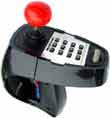 |
Fall 1982 |
Expansion Module #1: Atari 2600 Converter released Module #2, Driving Controller released |
|
Feb 1983 |
Super Game Module announced | |
Spring 1983 |
Super Game Module demoed (non-playable) at New York Toy Show |
|
May 1983 |
Advertising of the Super Game Module starts; runs through July |
|
Jun 1983 |
ADAM computer introduced | |
Aug 1983 |
Super Game Module schedule to go on sale | |
Oct 1983 |
Super Game Module dropped | |
Fall 1983 |
ColecoVision Roller Controller released ColecoVision Super Action Controllers released |
|
Winter 1983 |
The video game market begins to crash | |
Spring 1984 |
The video game industry collapses. All production stops. | |
Jan 1985 |
Coleco drops the ADAM computer | |
Mid 1985 |
Telegames picks up where Coleco left off, putting out new titles |
|
Fall 1985 |
Telegames starts selling the "Personal Arcade" ColecoVision clone through mailorder. |
|
1989 |
Coleco sells all remaining licenses and rights to toy giant Hasbro. |
|
Apr 1994 |
A tornado wipes out all remaining stock of the Personal Arcade system. |
|
1995 |
Telegames releases the "Personal Arcade" collection for PC/Windows platform. |
|
1996 |
First attempts at Colecovision homebrew development are done. |
|
Sep 2004 |
Telegames USA ceases all support for classic systems, including Colecovision |
|
Jan 2005 |
The Coleco brand is bought by River West Branding. Coleco.com website is revived. |
|
Spring 2005 |
Techno Source launches Coleco-brandedproduct line of LCD and TV games. |
|
Sep 2005 |
Techno Source Coleco Toys Win 2005 Awards From Dr. Toy. |
- MW, JH, JC, 03, 07, 10, 13, 14, 25, 50, & 65


